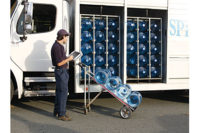Beer and wine producers represent a growing segment of the beverage industry today. According to the Brewers Association, Boulder, Colo., the number of breweries in the United States is at a 25-year high, with this growth attributed to the popularity of craft beers across every demographic. Craft beers include those produced by small- and medium-sized breweries as well as by large, well-known producers that have introduced a wide variety of specialty artisanal beers to meet consumer demand.
The wine industry also is burgeoning, with national winery association WineAmerica reporting that more wineries exist in the United States today than ever before. The expansion in the number, sizes and types of products has made logistics and distribution increasingly more complex and challenging for beer and wine distributors.
Direct store delivery challenges
With more products in each customer order, the drivers responsible for the direct store delivery (DSD) of beer and wine to route-based retail customers can find it more difficult these days to keep track of all the SKUs for sequential deliveries. Therefore, drivers need to plan their routes more precisely and strategically to ensure that they deliver the right order to the right place at the right time.
Adding to the complexity for DSD drivers is the need for an accurate paper trail, which is a key part of their administrative duties. After delivering an order, they must be prepared to issue a properly prepared receipt and take the next order. In addition, because craft beers often are freshness dated, they must also be ready to account for returns of any products that might have fallen out of date. Tracking this paperwork and presenting receipts and other documents in a clear, consistent and readable format is extremely important for maintaining a professional business image.
Just like distributors in the wider beverage and snack food markets, beer and wine distributors operate in a competitive business climate with tight profit margins, so delivery speed and efficiency are extremely important. To ensure maximum driver productivity, management needs to ensure that delivery routes are optimized across each assigned area of the city or region. Truck drivers should be trained to load trucks strategically, based on these optimized routes, and to unload in such a way that no time is wasted trying to find or assemble an individual customer’s order at the store. Likewise, the drivers’ issuance of paperwork should be fast and efficient.
These route management and accounting best practices not only save time for DSD drivers and store managers, but they also are good for business. A smooth, hassle-free delivery service accompanied by swift and accurate accounting is a great way to gain and retain customers while at the same time keeping cash flow and profitability at a healthy level.
How mobile technology and printing solutions support DSD
To help improve delivery time, serve more customers in a day, reduce hand-written errors, and improve cash flow, many beverage distributors have switched from using pens and paper to highly automated computer-based systems that include handheld devices, laptops and mobile printers. And, to better manage this mobile workplace, they can implement integrated route management software developed specifically to help reduce operating costs, increase driver efficiency and productivity, and improve customer service.
Based on innovative wireless technology, leading route management solution suites today typically integrate multiple functions, including sales, distribution and delivery, warehouse, inventory management, reporting and office processes, which all are accessible through a mobile wireless platform. These comprehensive business management software solutions now are being utilized by some of the largest and most successful beverage distributors.
An essential companion to route management solutions, mobile wireless printers provide the necessary accounting paper trail in a direct and immediate way. Today’s drivers are expected to make more deliveries each day to keep up with demand, and well-designed truck-mounted and/or handheld mobile printers deliver the speed and reliability to support this demand. Today’s marketplace offers next-generation mobile printers with a high degree of versatility, flexibility and ease of use to meet the needs of DSD-based businesses.
Paul Rutherford, vice president of Rutherford and Associates, Holland, Mich., describes how the powerful synergy between his firm’s eoStar route management software and mobile printers can improve distribution speed and efficiency at every level — from the bottling plants to distribution centers to stores. EoStar software, which integrates mobile device platforms with sales, distribution, warehouse and office operations, is used by leading beverage and snack food producers, wholesalers and distributors across North America.
“To stay competitive in today’s complex industry, distributors need a super-efficient mobility solution —one that combines business and route management software with a wireless mobile printing component,” Rutherford says. “Equally important, the solution must be simple and intuitive for the driver.”
Trends in next-generation mobile printers
The trend in mobile route accounting printers for DSD drivers has been toward faster, more durable devices. Depending on their business model and printing requirements, beer and wine distributors might want to evaluate 4- to 8.5-inch-wide mobile printers that can be handheld, hung from a belt or shoulder strap, or mounted in the vehicle.
The 4-inch models can be used, for example, to print out delivery receipts and invoices, returned goods receipts and labels, plus any pre-sales documentation needed, such as sales order history, product promotions and special deals. The full-page (8.5-inch wide) printers are ideal for printing delivery confirmation, receipts and invoices as well as larger documents, such as contracts, price lists, product and sales promotions, suggested planograms, route maps and more.
The following are some desirable features to look for in both types of mobile printers:
• Fast printing speeds to simplify accounting and keep drivers on schedule.
• Thermal printing technology with no messy inks or toners to deal with and thermal paper as the only consumable.
• Ability to print clear, legible and lasting documents with crisp text, graphics and pictures on-site, whether handheld or from the vehicle.
• Durable construction that is rugged enough to perform reliably in all kinds of weather conditions and to withstand the rigors of repeated, over-the-road operation.
• Compact and lightweight —easy to carry, operate and maintain by non-technical DSD drivers.
• A solid manufacturer’s warranty against defects and damage.
As the world of distribution continues to evolve and present new challenges, leading technology solution providers will continue to develop advances, such as route management software and mobile printers that help to reduce operating costs, increase the efficiency and productivity of drivers, and improve customer service.




